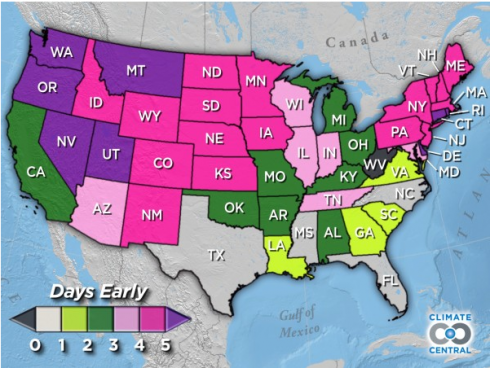CIR tallies the price of gas, including the externalities — the costs that are not included in the price we pay at the pump.
Spring is Coming Earlier

In Missouri, between 1981 and 2010 the average date at which trees first showed their leaves was two days earlier than the average between 1951 and 1980, according to this graphic by Climate Central.
You’ll also note the north-south trend, where change is greater as you go north. Most models predict that global warming/climate change due to increasing carbon dioxide will result in bigger changes as you get toward the poles.
The map is based on data from the National Phenology Network. The National Phenology Network has a good educational resource page, as well as access to their datasets.

Seeds of Change: Cotton
Andrew Sullivan compiles some interesting commentary on the extent of global cotton production (40% of all agricultural land), and the argument that all this production for cheap clothes is exacerbating hunger problems around the world.
Note: the history of cotton makes for a fascinating read.

The End of the Earth
The Earth will end with fire, non-metaphorically. It will be consumed when the sun expands as it runs out of fuel, 5 billion years from now.
Mastery Requires Persistence
It takes time, practice, and patience with seeing yourself do a lot of not-so-great work, before you eventually master a subject. Hard work not only builds character, it builds expertise.
Ira Glass recounts his experience:
Ira Glass on Storytelling from David Shiyang Liu on Vimeo.
(via The Dish)
The History of the Moon
In the early solar system, 4.5 billion years ago, the planets were still coalescing, something enormous hit the Earth.
After it formed, huge impacts shaped the surface of the moon into what we see today. NASA takes up the story:
These videos are awesome introductions to the early history of the Earth, Moon, and solar system.
Why Feburary 29th?
CGP Grey explains why we need leap days to fill in the calender.
Jupiter and Venus in Conjuction

Jupiter and Venus have been sitting near the western horizon, shining so brightly that even I have noticed them. Phil Plait explains with some back-of-the-envelope math, why Venus is brighter even though it’s smaller than Jupiter. It’s a nice example of how a little math can do a great job explaining how the world (and others) works.